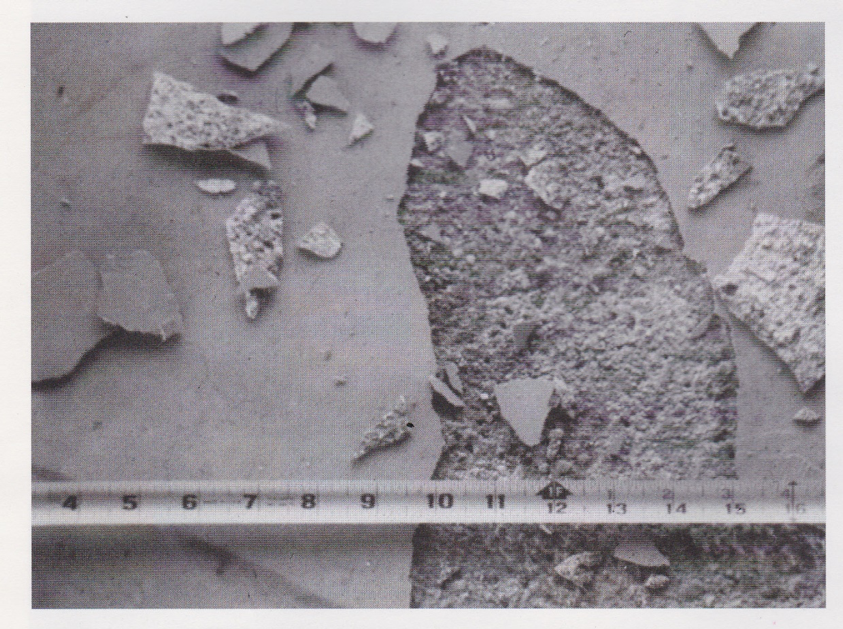Additional Resources
READY MIX TECH TOPIC:
Delamination and Blisters

BY DANIEL GREEN
Retired Technical Services Manager, National Cement
Most articles say that delamination is similar to blisters. True. They are difficult to detect during finishing but become apparent after the surface has somewhat hardened. Delaminated areas usually show up as cracked, hollow sounding areas, aggravated when crushed under traffic. They may be a few square inches to several square feet in surface area. Blisters usually show up as bumps anywhere from ¼” to 4” in diameter. In both cases, the thickness of the delaminated surface, or the delaminated mortar portion at the surface, is usually 1/8” to ¼”.
The cause: rising bleed water and air become trapped just below the concrete mortar surface that has been prematurely sealed, closed, densified by finishing operations. The Portland Cement Association in their Bulletin IS177T discuss the primary cause is finishing the surface before bleeding has occurred (or while bleeding is occurring). Additionally, it states that delamination is more likely to occur when factors that extend the bleeding time of concrete (cold substrate) are combined with factors that accelerate surface setting (high air temp).

Photo: Delamination as the result of sealing the surface before bleeding has occurred or concluded. Photo taken from PCA IS 177T.
The PCA continues by discussing that finishing the concrete when it is still spongy will tend to force entrapped air toward the surface. Blisters or delamination may not appear after the first pass but as the work progresses during the second or third pass the angle of the trowel blades are usually increased. Air (and perhaps water) is forced ahead of the blade until enough is concentrated to form the blisters or delamination. If these defects are noticed during finishing, a second floating may reduce them and a delayed troweling will depress them, although complete bond may not re-establish. So great attention must be focused onto this effort.
The National Ready Mixed Concrete Association in their CIP-20 add to the above PCA discussion by saying that delamination occurs when the fresh concrete surface is sealed while the concrete is still plastic and continues to bleed water and/or release air. Delaminations form fairly late in the finishing process after floating and after the first troweling pass. They can, however, form during the floating operation if the surface is overworked and densified.
Once the concrete has achieved final set, no additional or new delamination or blistering can take place. The process of delamination or blistering can only occur prior to the final set of the concrete while there is bleeding of water or air.
A delayed initial set and a reduction in the rate of bleeding will increase the chances for delamination and blisters. Entrained air in concrete reduces the bleed rate because the air has a blocking effect on the bleed channels. A cool subgrade delays set in the slab bottom relative to the slab top.
DELAMINATION AND BLISTERING IS MORE LIKELY TO FORM IF:
-
The underlying concrete sets slowly due to cool subgrade.
-
Slow setting concrete
-
The air content is higher than desirable for the application. (therefore blocking bleed channels and slowing the bleed rate).
-
Rapid drying (from wind or sun) of the surface causing it to “crust” over making it appear ready to trowel.
-
Overworking/finishing the surface.
-
A thick slab.
-
Concrete placed directly on a vapor barrier.
-
An overly sticky concrete mix from high sand or cement fines.
REPAIR OF DELAMINATION AND BLISTERS:
-
Detecting delaminated /blistered areas: aside from visible inspections of these areas, sounding with a hammer or a chain drag is usually the normal course.
-
Remove the unsound layer areas using standard hammer and chisel methods. For larger areas surface grinding may be required. Clean off all loose material.
-
Repair using standard repair mortar: graded sand, cement, bonding agent.
-
Use standard curing practices.